Names link to more information on identification and management.
Click on photos to enlarge
| Mites |
Mite damage |
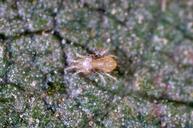
Twospotted spider mite adult
Identification tip: Greenish to yellow globe-shaped
bodies with conspicuous dark spots. |
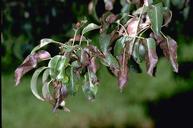
Twospotted spider mite damage
Identification tip: Blackening of pear leaves. |
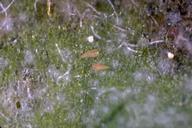
Pear rust mites
Identification tip: Tiny, wedge-shaped bodies. Adults
pale white to cream colored during the growing season. |
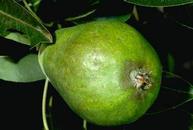
Pear rust mite damage
Identification tip: Localized uniform russeting
on fruit. |
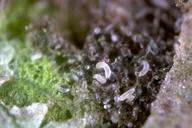
Pearleaf blister mites
Identification tip: Tiny with a white, long, slender,
and striated body inside leaf blister. Immature form resembles
adult but smaller. |
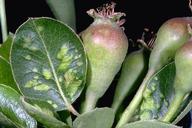
Pearleaf
blister mite damage
Identification tip:Leaf blisters, 1/8- to 1/4-inch
across, first red and later blacken. |
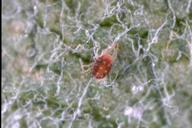
European red mite adult
Identification tip: Dark red with white spots
at the base of 6 to 8 hairs on the back. |
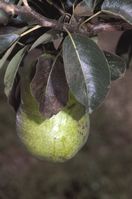
European red mite damage
Identification tip: Stippled and bronzed leaves
that may turn brown and dry. |
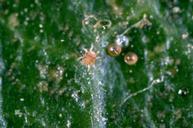
European red mite nymph
Identification tip: Immature mites are bright
red. |

European red mite eggs
Identification tip: Globe shaped and red with
a slender stalk (stipe) rising from the top center. |
| Caterpillars— |
Caterpillar damage |
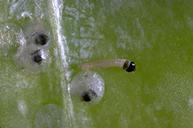
Codling moth eggs and
larva
Identification tip: Eggs disk shaped. Newly hatched
larva white with black head. |
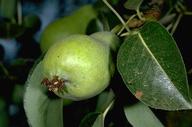
Codling
moth damage
Identification tip: Fruit tunnel plugged with
frass. Calyx entries difficult
to detect without cutting the fruit. |
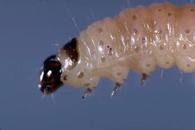
Codling moth mature larva
Identification tip: Mature larva 1/2 to 3/4 inch
long, pinkish white, with mottled head. |
|
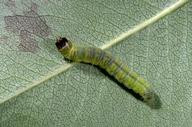
Obliquebanded leafroller larva
Identification tip: Greenish yellow with brown
to black head. |

Obliquebanded
leafroller larval damage
Identification tip: Superficial feeding on
fruit under leaves tied to fruit, or where two fruit touch. |
| Plant bugs— |
Plant bug damage |
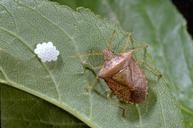
Stink bugs adult and egg
mass
Identification tip: Shield-shaped body; species
may differ in color and size (consperse shown here). Eggs
(left) barrel shaped, laid in clusters. |
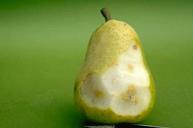
Stink bug and western
boxelder bug damage
Identification tip: Irregularly darker depressed
areas on mature fruit with hard, white pithy areas under
skin. |
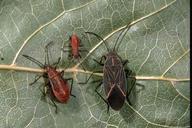
Western
boxelder bug nymphs and adult
Identification tip: The adult (right) is mostly
black with a red abdomen and red line markings on the wings.
Young nymphs are bright red to dark red. |
|
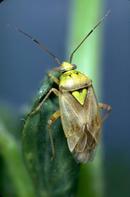
Lygus bug adult
Identification tip: Prominent triangle in center
of the back. |
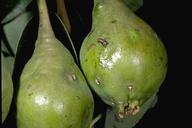
Lygus
bug damage
Identification tip:
Depressed areas with slightly swollen center caused by
midseason feeding, similar to that of stink bug. However,
stink bug damage concentrated near stem end of fruit and
lygus bug damage located anywhere on fruit surface. |
| Other insects— |
Other insect damage |

Katydid nymph
Identification tip: Resemble grasshoppers but
have long antennae. Nymphs wingless. (Banding on the antennae
seen only in the first instar). |
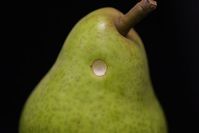
Katydid damage
Identification tip:
Bite marks approximately 1/3 inch wide and 1/5 inch deep. |
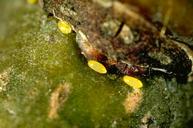
Pear psylla eggs
Identification tip: Tiny, elongated, yellowish
eggs laid on the underside of the leaf next to midrib. |
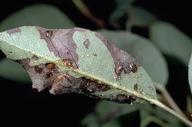
Pear psylla damage
Identification tip: Leaves yellow and portions of
the leaf blacken from feeding and injection of a toxin. |
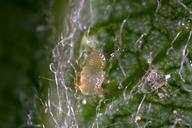
Pear psylla nymph
Identification tip: First and second instar
nymphs yellow with red eyes; bodies encased in honeydew.
(Third instar yellowish green and fourth instar greenish
brown—neither depicted). |
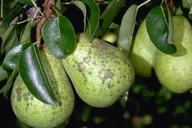
Pear psylla damage
Identification tip: Black sooty mold grows
on honeydew, resulting in fruit skin russet. |
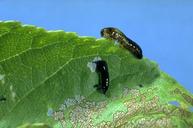
Pear slug (pear
sawfly) larvae
Identification tip: Slimy, olive green coating
over slug-shaped body; foliage skeletonized with all tissue
removed except fine network of veins. |
|
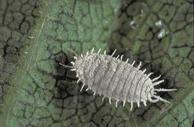
Mealybug (grape, obscure)
nymph
Identification tip: Closely resemble one another.
Mature females about 1/5 inch long with dark purple-gray,
somewhat flattened bodies; uniformly covered with a white
powdery wax. |
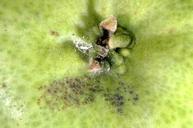
Mealybug (grape, obscure)
damage
Identification tip: Feed in the calyx end of
maturing fruit and secrete honeydew that can cause skin
russeting; black sooty fungus may grow on honeydew. |


